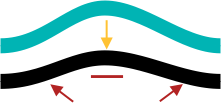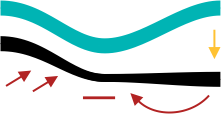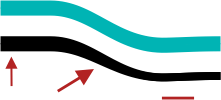Dies ist eine alte Version des Dokuments!
Translations are in progress
Line Tactics 1: Closed Line
On this site I try to shin a light on the most essential tactics in pure linefight situations. We look at a section in the middle of the line that can noch be flanked and has no lateral borders. THe sole topic is the possibilities of the line itself It's about a line where the opponent present itself wit ha curve or bend or these developed through the fight.
Wie immer bin ich an Kritik und Hinweisen interessiert. ( )
)
The end of the line are a special case, because the persons at the end can only be threatened from one direction which results in different possibilities, more about that later.
Reactions
A list of simple reactions to lineshifts The actions and reactions normally happen dynamical und relate to each other mutually. In other words: What is an outward dent for one sid is an inward dent for the other; what is a dent on the right for one, is a dent on the left for the other.
Outwards Dent 1
Situation: Your team managed to push forward in the middle creating an outwards dent. The opponent's line was not broken. Your teammates in the dent are now vulnarable from three sides. The dent can slowly be corroded by the opponent. The opponent's center is weakened but still strong enough to hold.

Reaction 1: Hold the left flank and the center. On the right flank push diagonally to the right and front preferably with long weapons.

Reaction 2: Starting from the dent push to the right and left alternatingly. /* Ist das ein Wort? Alternatingly?/*
Outwards Dent 2
Situation: Your team created an outwards dent but did not break the opponent's line. The dent can now be attacked from three sides and slowly be corroded. The opponent's center does not seem weakend. It's probably retreating on purpose to lure you in.

Reaction: Pull back the center. Push on both flanks.
Inwards Dent
Situation: The opponent's center pushed forward but did not break your line. Your own center is weakend. Most often this situation occurs after a failed attempt to break through the line. The other possibility is that your flanks are advancing too fast.

Reaction 1: By all means, hold the center!
The opposing fighters who advanced the most are vulnarable from three sides. Attack the dent forcefully preferably with daneaxes from the right side and spears from the left side.

Reaction 2: By all means, hold the center!
Pull back the right flank. If this frees up any fighters use them to reinforce the center. Make sure you got a stable front at the left flank and push diagonally to the right from there.
Dent on the left flank
Situation: Die rechte Seite ist zurückgefallen und geschwächt.

Lösung: Die vorstehende Position wird gehalten, während die Langwaffen nach schräg rechts Druck ausüben. Dies kann durch leichten Druck in der Mitte unterstützt werden. Die linke Flanke muss gehalten werden!
Wenn eine Lücke entsteht, muss die Linie weiter gehalten werden und geeignete Läufer müssen bereit sein!
Dieses Manöver wird Ausdrücken genannt.
Dent on the right flank
Situation: Die linke Seite ist zurückgefallen und geschwächt.

Lösung: Die rechte Seite wird zurückgezogen und eine Verstärkung der linken vorgenommen. Auf der Spitze der Beule wird starker Druck mit Langwaffen ausgeübt. Zur Irritation kann auf der linken Flanke noch ein zusätzlicher Stoß ausgeführt werden.